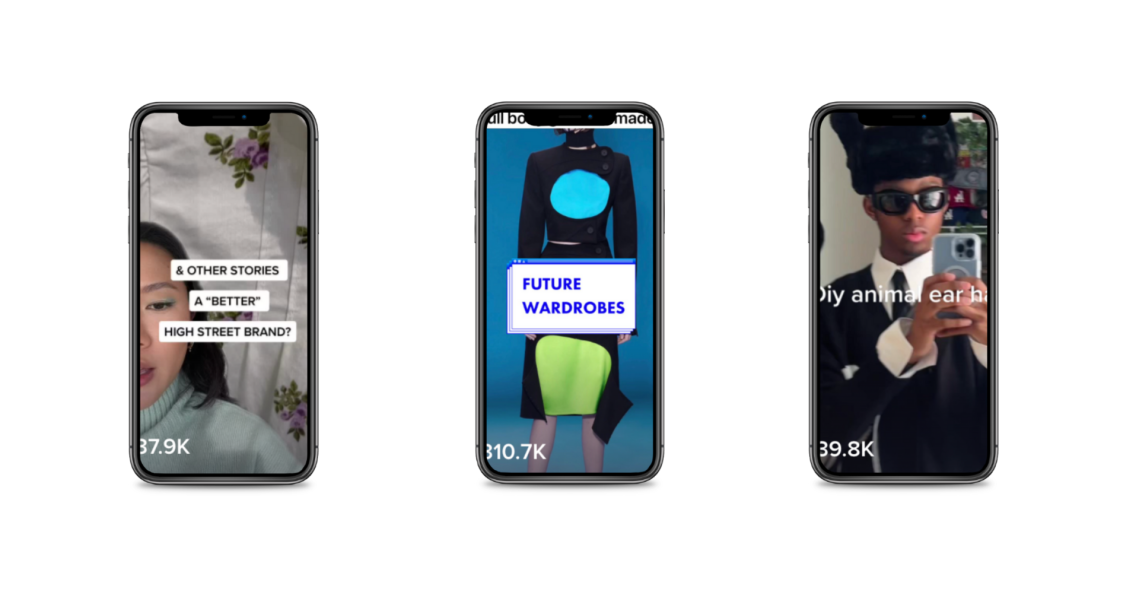TikTok’s potential as an educational platform is becoming apparent. In 2021, the platform began promoting the hashtag #DidYouKnow, which now has 16.4 billion views. And, increasingly, brands are reaching Gen Z by partnering with influencers who are successful at driving engagement through education.
Many influencers have grown large audiences by providing information on sustainability — or the lack thereof — in fashion. They’re creating short, snappy videos on everything from climate change to thrifting to upcycling.
Kai McPhee (@knawt.kai, 260,000 TikTok followers) has been promoting sewing on TikTok since 2020. “The biggest thing I try to push out is that you don’t need a lot of money to dress how you want. Instead of just spending all my money on clothes, I decided to invest in a sewing machine and go thrifting and make my clothes,” he said.
McPhee has worked with fashion brands like L.A.-based MNML and Pacsun by adding patches and other embellishments to their clothes in TikTok videos. “With Pacsun, I showed that you don’t need to have $2,000 to wear a nice pair of jeans,” he said. As part of his Earth Day collaboration with the brand, the sustainability-conscious influencer updated a pair of Pacsun jeans to give them the look of a pair by Japanese denim brand Kapital. The video generated 20,000 views.
Typically, McPhee posts videos showing his process of updating pieces in his own wardrobe with DIY elements. He’s also posted TikToks on styling tips, the pieces he’s selling on Depop and his process of making Raf Simons lookalike jeans.
For McPhee, TikTok’s ease and community are the draws. “I have a YouTube channel, but I’m not as active on there because it takes much longer to produce an idea that people are willing to sit around and watch,” he said. “With TikTok, I just come up with an idea, film it and edit it in 15 minutes.”
Agus Panzoni (@thealgorythm, 258,000 TikTok followers), meanwhile, focuses her videos on backcasting, or the process of reverse fashion forecasting. In other words, she takes predictions for future innovations and reverse-engineers them to see how they can be made a reality. Panzoni was previously a trend forecaster at WGSN and has been using TikTok since 2020. Her goal is to showcase the role trend forecasting has in creating a more sustainable fashion industry, through her partnerships with companies like educational platform TED.
Ad position: web_incontent_pos1
“I’ve been speaking more about trying to decelerate the trend cycle,” she said. “I question the trend narratives: Do trends need to die or can we extend them? The fact that the media doesn’t talk about a particular trend anymore doesn’t necessarily mean it’s gone entirely. People are very much still dressing ‘normcore.’ Jeans, sneakers and oversized looks are always going to be a thing.”
Her channel highlights emerging innovations much like forecasting platforms do, but in digestible, three-minute videos. She’s made TikTok videos on topics including clothing modularity, future wardrobes and the use of mushrooms in beauty and fashion, for example. For the latter, she partnered with fashion search platform Lyst for data insights.
Panzoni’s loyal audience has also responded to her recommendations of lesser-known sustainability-focused designers like Clarissa Larrazabal. The brand now has 10,000 Instagram followers.
“One of the biggest challenges creators face, when it comes to subjects like climate change, is how to create narratives that activate audiences without [making them] scared,” she said, noting that TikTok has made it easier. “People just speaking to the camera in their house has a very scrappy feeling, but it also feels real and peer-to-peer. Plus, with [TikTok’s features like] stitching and editing, it allows for a conversation.”
Finally, Andrea Cheong’s (@andreacheong, 162,000 TikTok followers) audience looks to her to pinpoint the long-lasting investment pieces in brands’ seasonal collections. She got her start on the platform through an introduction by a TikTok scout, who contacted her after she wrote about #StopAsianHate for British Vogue. TikTok scouts are charged with finding people who will resonate on the app and then working with them to learn the tools and secure engagement.
Ad position: web_incontent_pos2
As Cheong’s content quickly took off, with videos on how to get an Hermès bag (595,000 views) and which accessories to avoid from Zara (56,000 views), she made sure to stay away from traditional influencer hauls which encourage overconsumption. Previously an Instagram influencer who regularly posted editorials, she grew uncomfortable with her role in the industry. She decided to change her content focus and launched the Mindful Monday Method program on her channel to encourage mindful shopping.
Now, Cheong focuses on TikTok, with her videos spotlighting well-made pieces and fashion insider secrets from her days working in the industry. She partners with brands she believes in like Beauty Pie and jewelry brand Astley Clark.
According to a 2019 study by retail analytics company First Insight, the vast majority of Gen-Z shoppers prefer to buy sustainable brands and will spend 10% more to buy sustainable products. It also revealed that value-based purchasing is most common among Gen-Zers and millennials. According to a 2019 report by McKinsey, Gen Z’s annual spending power in the U.S. is $150 billion.




